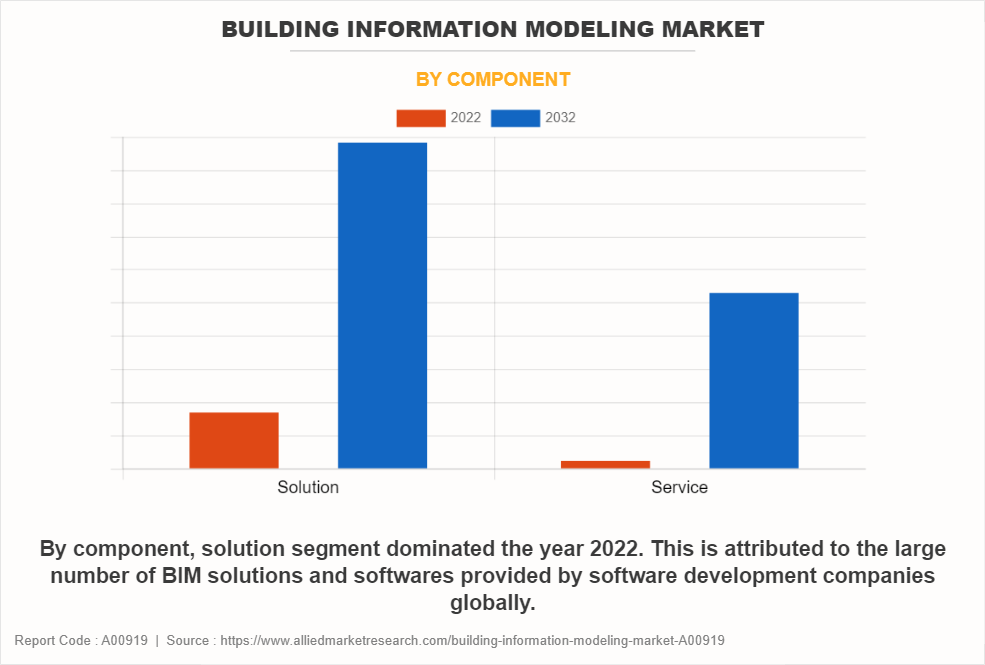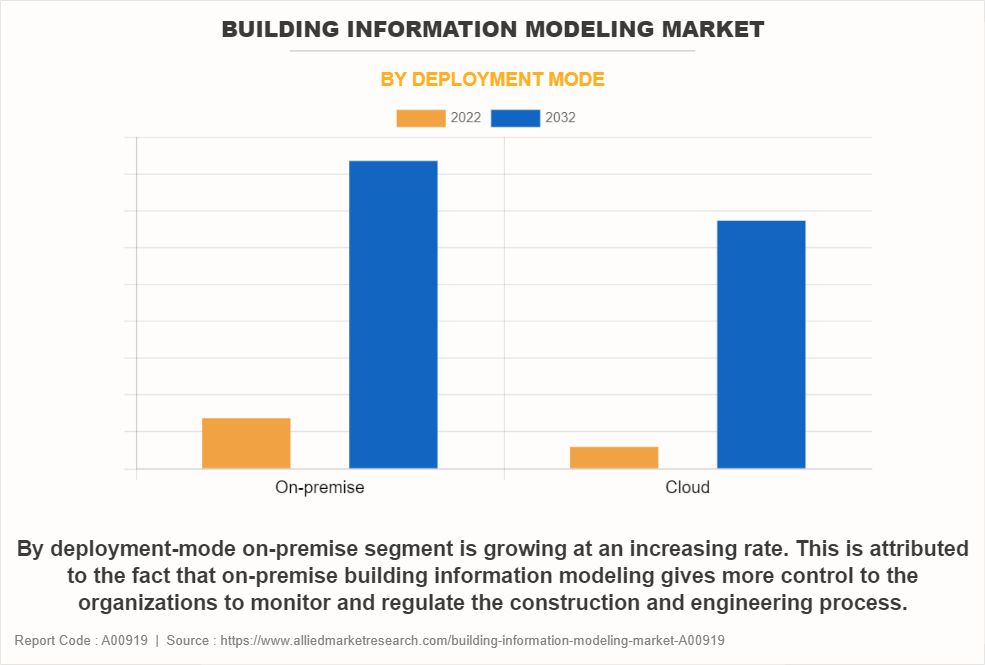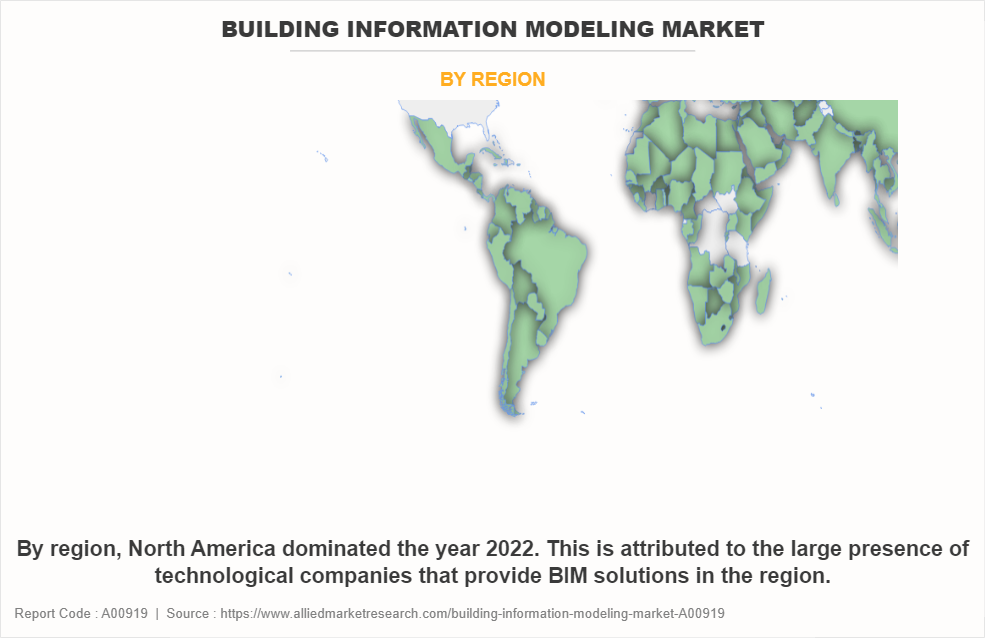Building Information Modeling (BIM) Market Overview
The global building information modeling market size was valued at USD 7.9 billion in 2022 and is projected to reach USD 34.2 billion by 2032, growing at a CAGR of 16% from 2023 to 2032 during the market forecast.
The key factors such as government mandating for building information modeling usage (BIM) and the increasing adoption of digital technology by construction sector are driving building information modeling market growth. Furthermore, increasing initial expenditure on BIM technology is expected to hamper the market growth during the forecast period. Moreover, the emergence of virtual reality (VR) and augmented reality (AR) technologies and their integration with BIM is providing an opportunity for growth of BIM market size during the forecast period.
Key Market Insights
- On application, the planning and modelling segment led the BIM industry in terms of revenue in 2022.
- By component, the service segment is expected to grow during the forecast period
- Region wise, North America generated the highest revenue in BIM market in 2022.
Market Size & Forecast
- 2032 Projected Market Size: USD 34.2 Billion
- 2022 Market Size: USD 7.9 Billion
- Compound Annual Growth Rate (CAGR) (2023-2032): 16%

What is Building Information Modeling (BIM)
Building Information Modeling (BIM) technology is a powerful and innovative approach to the planning, design, construction, and management of buildings and infrastructure. It involves creating digital representations of the physical and functional characteristics of a facility. Furthermore, BIM software can be integrated with cost estimation tools, allowing real-time cost analysis during the design phase. This helps with accurate budgeting and cost control throughout the project lifecycle. Moreover, BIM technology assists in creating construction schedules and sequencing plans. Contractors can visualize the construction process, optimize workflows, and identify potential bottlenecks, leading to more efficient construction operations.
The report focuses on growth prospects, restraints, and trends of the building information modeling market analysis. The study provides Porter five forces analysis to understand the impact of various factors, such as bargaining power of suppliers, competitive intensity of competitors, threat of new entrants, threat of substitutes, and bargaining power of buyers, on the building information modeling market share.
BIM Market Segment Review:
The building information modeling industry is segmented based on component, deployment mode, project life cycle, building type, application, end-user and region. In terms of component, the building information modeling bim market is divided into solution and services. By deployment mode the market is divided into on-premise and cloud-based. By project life-cycle the market is divided into preconstruction, construction and operations. By building type, the market is divided into commercial, residential and industrial. By Application, the market is divided into planning & modelling, construction & design, asset management, building system analysis & maintenance scheduling and others. By end user, the building information modeling market is divided into architects/engineers, contractors and others. By region-wise the BIM market is divided into North America, Europe, Asia-Pacific and LAMEA.

Based on component, the solution segment dominated the building information modeling security market in the year 2022. This is attributed to the various features provided by the BIM software such as 3D visualization of buildings, reduced costs and time, and flexible design changing of construction models. However, the service segment is expected to grow during the forecast period. This is attributed to the increasing growth of third-party software service providers in the world.

Based on deployment mode, the on-premise segment is expected to grow in the future. This is attributed to the complete control of organization over their on-premise data base and technology as compared to cloud.

Based on region, North America dominated the year 2022. This is attributed to large BIM software providers present in the region. In addition, large technological advancements in field of AI, cloud, ML abd others happening in the region.
What are the Top Impacting Factors of BIM Market
Government mandating Building Information Modeling (BIM) usage
Several governments around the world have taken steps to mandate and encourage the use of building information modeling (BIM) technology in construction projects. These mandates are driven by the potential benefits of BIM, including improved project efficiency, reduced errors, enhanced collaboration, and long-term cost savings. The building and construction authority (BCA) of Singapore introduced the BIM e-submission mandate. This mandate requires architectural and engineering plans for certain types of projects to be submitted in BIM format. The mandate aims to improve collaboration and efficiency in the construction industry.
Furthermore, the Norwegian government has implemented BIM mandates for public projects, emphasizing the use of open standards. The mandates are aimed at improving the quality of project documentation and promoting collaboration among stakeholders. Moreover, some states and local governments in the U.S. have implemented their own mandates and requirements for BIM in public projects. In addition, organizations like the General Services Administration (GSA) have encouraged the use of BIM in federal construction projects. Therefore, all these factors are driving the growth of the building information modeling industry.
Increasing Adoption of Digital Technology by Construction Sector
BIM facilitates the seamless sharing and collaboration of digital models among architects, engineers, contractors, and other stakeholders. Digital technology enables real-time collaboration, allowing teams to work together regardless of their geographical locations. This collaborative approach streamlines the construction process, reduces errors, and enhances overall project efficiency. Furthermore, digital technologies, including BIM, generate vast amounts of data related to construction projects. This data can be analyzed to gain valuable insights, predict outcomes, and make data-driven decisions. Construction companies are increasingly leveraging this data for project planning, risk management, and resource optimization. Therefore, all these factors are expected to escalate the growth of the BIM industry during the forecast period.
Increasing initial expenditure on Building Information Modeling (BIM) Technology
Small and medium-sized construction firms, which contribute towards a significant portion of the industry, often have limited budgets. The substantial initial investment required for BIM software licenses, hardware, and training is sometimes prohibitive for these companies, preventing them from adopting BIM technology. Furthermore, implementing BIM technology involves not only purchasing software but also investing in training programs for employees. Learning to use BIM effectively requires specialized skills, and training can be costly and time-consuming. Companies need to allocate additional resources for training their workforce, which adds to the overall initial expenditure.
Moreover, BIM software often demands powerful hardware to run efficiently. Companies might need to invest in high-performance computers and other hardware infrastructure to support BIM applications. In addition, the cost of software licenses and updates can be significant, especially for advanced BIM tools. Therefore, all these factors are expected to hold back the BIM market growth during the forecast period.
Integration of Virtual Reality (VR) and Augmented Reality (AR) Technologies with Building Information Modeling (BIM) Technology
VR and AR technologies allow stakeholders to visualize BIM models in immersive 3D environments. This enhances the understanding of complex architectural and engineering designs. Clients, architects, and construction teams can experience the project in a more intuitive manner, improving communication and collaboration among various stakeholders. Furthermore, VR and AR enable interactive design reviews where project stakeholders can explore virtual models in real-time. This immersive experience allows for better feedback and decision-making during the design phase. Issues can be identified and resolved more effectively, leading to improved design quality and reducing the likelihood of errors during construction.
Moreover, integrating BIM with AR allows facility managers to access BIM data overlaid onto the physical building. This facilitates efficient facility management, enabling managers to identify components, access maintenance records, and visualize hidden infrastructure systems. AR-based maintenance instructions enhance the speed and accuracy of repairs and upgrades. In addition, the BIM market for VR and AR technologies is growing at an increasing rate. For instance, in 2023, Statista has stated that number of AR and VR market users are expected to reach 6,786.0 m users by 2027. Moreover, user penetration is projected to be 92.2% in 2023 and is expected to increase to 103.6% by 2027. Therefore, all these factors are expected to provide a significant opportunity for building information modeling market growth during the forecast period.
Which are the Leading Companies in Building Information Modeling (BIM)
The following are the leading companies in the online trading platform market. These players have adopted various strategies to increase their market penetration and strengthen their position in the global BIM market.
Aveva Group Plc.
Hexagon AB
Trimble Inc.
Autodesk Inc.
Beck Technolgy Ltd.
Pentagon Solution Ltd.
Nemetschek SE
Bentley Systems Inc.
Dassault Systemes
Asite Solutions Ltd.
Which sectors are Driving the Demand for BIM Solutions
Industries such as construction, architecture, and engineering are increasingly adopting BIM technology. It allows for better collaboration, improved project visualization, and enhanced decision-making processes. Furthermore, BIM integrated with IoT sensors is a trend, enabling real-time monitoring of buildings and infrastructure. This integration provides valuable data for maintenance and operational purposes. Moreover, BIM usage is extending beyond design and construction phases to include facility management and maintenance. This lifecycle approach is establishing BIM as a valuable tool throughout the entire lifespan of a building and infrastructure. Therefore all these factors are driving building information modeling market trends.
What are the Most Recent Acquisitions and Product Launch in the BIM Industry
Acquisition
In april 2023,site Solutions Limited acquired 3D Repo, a pioneer in cloud-based Building Information Modelling (BIM) collaboration software. The combination brings together two innovative companies with complementary technologies and expertise, with the aim of driving digitization in construction to new heights.
Product Launch
In march 2021, Autodesk Inc. launched Autodesk launchoff, a new product that empowers estimators to perform 2D and 3D quantification workflows from a common data environment to increase collaboration, speed and accuracy during the estimation process in relation to construction costs.
Building Information Modeling Market Report Highlights
| Aspects | Details |
| Market Size By 2032 | USD 34.2 billion |
| Growth Rate | CAGR of 16% |
| Forecast period | 2022 - 2032 |
| Report Pages | 494 |
| By Deployment Mode |
|
| By Building Type |
|
| By Application |
|
| By End-User |
|
| By Component |
|
| By Region |
|
| Key Market Players | Dassault Systemes, Pentagon Solutions Ltd., Asite Solutions Ltd., Autodesk Inc., AVEVA Group PLC., Trimble, Inc., Bentley Systems, Incorporated, Beck Technology Ltd., HEXAGON AB, Nemetschek Group |
Analyst Review
Government mandating for building information modeling usage (BIM) and the Increasing adoption of digital technology by construction sector are two main factors driving the growth of building information modeling market. This is attributed to the favorable government policies implemented by the government to support efficient construction operations and the accurate ability of the digital construction to address the challenge of low productivity in the construction sector. Furthermore, increasing initial expenditure on BIM technology is expected to hamper market growth. This is attributed to the high costs associated with BIM software and hardware, training and education in relation to BIM, process changes related to BIM that are expensive and time consuming and high cost associated with data management. Moreover, the emergence of virtual reality (VR) and augmented reality (AR) technologies and their integration with BIM is providing an opportunity for market growth. This is attributed to the improved communication among stakeholders and the availability of better visuals for designers, engineers, and other stakeholders, enabling a highly immersive experience benefits provided by the AR and VR technologies.
The market players are adopting strategies like product launch for enhancing their services in the market and improving customer satisfaction. For instance, in November 2022, Bentley Systems Incorporated launched bentley infrastructure cloud. The solution is powered by the iTwin platform and Bentley's infrastructure schemas and thus seamlessly integrating with Bentley's engineering applications, making it possible to create, deliver, and operate better infrastructure over time by using complete and evergreen digital twins. In addition, in March 2023, Trimble Inc. launched the latest versions of its Tekla software for constructible building information modeling (BIM), structural engineering and steel fabrication management. Furthermore, some companies adopted acquisition strategies to grow in the market. For instance, in September 2022, Hexagon AB acquired iConstruct Pty Ltd, a provider of award-winning building information modelling (BIM) software used in commercial, infrastructure and industrial construction. In addition, in April 2023, Asite Solutions Limited acquired 3D Repo, a pioneer in cloud-based Building Information Modelling (BIM) collaboration software. The combination brings together two innovative companies with complementary technologies and expertise, with the aim of driving digitization in construction to new heights. Therefore, such strategies are expected to boost the growth of the building information modeling market in the upcoming years.
The key players profiled in the building information modeling in ICT market analysis are Aveva Group Plc., Hexagon AB, Trimble Inc., Autodesk Inc., Beck Technolgy Ltd., Pentagon Solution Ltd., Nemetschek SE, Bentley Systems Inc., Dassault Systemes, and Asite Solutions Ltd. These players have adopted various strategies to increase their market penetration and strengthen their position in the building information modeling industry.
The global building information modeling market size was valued at USD 7.9 billion in 2022, and is projected to reach USD 34.2 billion by 2032
The global building information modeling market is projected to grow at a compound annual growth rate of 16% from 2023-2032 to reach USD 34.2 billion by 2032
Aveva Group Plc., Hexagon AB, Trimble Inc., Autodesk Inc., Beck Technolgy Ltd., Pentagon Solution Ltd., Nemetschek SE, Bentley Systems Inc. Dassault Systemes Asite Solutions Ltd.
North America is the largest regional market for building information modeling market.
Government mandating Building Information Modeling (BIM) usage , Increasing Adoption of Digital Technology by Construction Sector, Increasing initial expenditure on Building Information Modeling (BIM) Technology & Integration of Virtual Reality (VR) and Augmented Reality (AR) Technologies with Building Information Modeling (BIM) Technology
Loading Table Of Content...
Loading Research Methodology...



